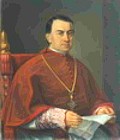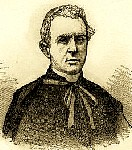The Cardinals of the Holy Roman Church - Biographical Dictionary (original) (raw)
The Cardinals of the Holy Roman Church Biographical Dictionary Pope Pius IX (1846-1878) Consistory of December 28, 1877 (XXIII)

(122) 1. MORETTI, Vincenzo
(1815-1881)
Birth. November 14, 1815, Orvieto. Son of Domenico Moretti and Elisabetta Mazzoni-Brancaleone. Received the sacrament of confirmation on April 24, 1821. His brother Francesco was canon, archpriest and pastor of the cathedral of Orvieto.
Education. Studied at the Jesuit Collegio in Orvieto; at the Seminary of Orvieto; and at Collegio Romano, Rome, where he earned doctorates in theology on May 31, 1844; and in utroque iuris, both civil and canon law, on March 9, 1848. He received the ecclesiastical tonsure on December 18, 1830.
Priesthood. Ordained, September 22, 1838. In the diocese of Orvieto, prosynodal examiner; canon theologian of its cathedral chapter on October 18, 1845, with the injunction by the bishop, Giuseppe Maria Vespignani, who had strongly encouraged and almost forced him to participate in the competition for the theological prebend, infra annum to obtain a doctorate in theology; a few months later, he asked for an extension, complaining of being already engaged in the completion of the law course in Rome (begun four years earlier); named professor of Sacred Scriptures and ecclesiastical history in its lyceum on December 30, 1848; pro-vicar general in 1851.
Episcopate. Elected bishop of Comacchio, December 17, 1855 (1). Consecrated, January 13, 1856, church of Tor di Specchi, Rome, by Cardinal Costantino Patrizi, bishop of Albano, assisted by Antonio Ligi Bussi, titular archbishop of Iconio, vice-gerent of Rome, and by Gregorio Bizzarri, titular archbishop of Filippi, secretary of the S.C. of Bishops and Regulars. He entered the diocese on March 15, 1856. The faithful received him enthusiastically but the city government, led by Carlo Cavalieri Ducati, remained always hostile. Cavalieri Ducati's successor, his relative Giovanni of the same last name, asked Bishop Moretti to celebrate a solemn Mass and a Te Deum for the feast of the Statuto of May 13, 1860. The bishop refused based on his conscience's objection and on the night of July 21, 1860, the mayor placed him under house arrest in the episcopal palace. He was released on the morning of October 7, 1860, after a decree from the Ministry of Religious Affairs, dated September 29, granting amnesty to the clergy prosecuted or sentenced to correctional penalties. In the meantime, Bishop Moretti received the papal bull transfering him to to the see of Cesena, dated March 23, 1860. He could not take possession of the see because Cardinal Giacomo Antonelli, secretary of State, prescribed not to request the royal exequatur (2) and thus he remained in Comacchio; there, he worked for the transfer, obtained from Pope Pius IX in 1857, of the territory of Mesola from the archdiocese of Ferrara to the diocese of Comacchio. Assistant at the Pontifical Throne, September 18, 1863. Transferred to the see of Imola, March 27, 1867. Participated in the First Vatican Council, 1869-1870; he supported the dogmatic declaration of the papal infallibility; on September 20, 1870, he returned to Imola having left Rome because the Council had been suspended because of the start of the Franco-Prussian War. Promoted to the metropolitan see of Ravenna, October 27, 1871. On November 6, 1871, he asked instructions to the Secretariat of State on the fate of translated bishops, uncertain about his destination and the loss of the temporality of the see he was leaving. His attempt to stay in Imola failed because the Holy See ordered him to take possession of the new diocese. In 1876, he attended the Third Catholic Congress of Bologna. After 1876, the Holy See granted to the bishops to make indirect request of the exequatur from the Italian government; because of his intransigence and the accusations that he had hindered the Left in local elections, he never obtained it. In Ravenna he found an intense anti-clericalism welded to the demands of a social revolution by Mazzini's associations and the propaganda of Mikhail Alexandrovich Bakunin, the Russian revolutionary anarchist, and founder of collectivist anarchism.
Cardinalate. Created cardinal priest in the consistory of December 28, 1877; received the red hat and the title of S. Sabina, December 31, 1877. Participated in the conclave of 1878, which elected Pope Leo XIII. Apostolic administrator of the diocese of Comacchio and of the Pomposiana provostship, April 25, 1878. Resigned the pastoral government of the archdiocese of Ravenna, September 22, 1879. He retired to live in Rome.
Death. October 6, 1881, in Bologna. Exposed in the parish church of S. Martino, Bologna, and buried in the church of San Girolamo alla Certosa in that city. His funerary monument was sculpted by Enrico Barbieri in 1883 and designed by Alfredo Tartarini.
Bibliography. "Cardinali defunti." La Gerarchia Cattolica e la Famiglia Pontificia per l'anno 1903, Città del Vaticano : Tipografia poliglotta vaticana, 1903, p. 175; LeBlanc, Jean. Dictionnaire biographique des cardinaux du XIXe siècle : contribution à l'histoire du Sacré Collège sous les pontificats de Pie VII, Léon XII, Pie VIII, Grégoire XVI, Pie IX et Léon XIII, 1800-1903. Montréal : Wilson & Lafleur, 2007. (Collection Gratianus. Série instruments de recherche), p. 662-663; Ritzler, Remigium, and Pirminum Sefrin. Hierarchia Catholica Medii et Recentioris Aevi. Volumen VIII (1846-1903). Patavii : Typis et Sumptibus Domus Editorialis "Il Messaggero di S. Antonio" apud Basilicam S. Antonii, 1979, pp. 23, 52, 168, 217, 320 and 477; Weber, Christoph. Kardinäle und Prälaten in den letzten Jahrzehnten des Kirchenstaates : Elite-Rekrutierung, Karriere-Muster u. soziale Zusammensetzung d. kurialen Führungsschicht zur Zeit Pius' IX. (1846-1878). Stuttgart : Hiersemann, 1978. (Päpste und Papsttum; Bd. 13, I-II), II, 489 and 758.
Webgraphy. Biographyby Saretta Marotta, in Italian, Dizionario Biografico degli Italiani - Volume 76 (2012), Treccani; his photograph, Araldica Vaticana; his portrait by an unknown painter, ambito italiano; secolo XIX (1874), Beni storici e artistici, Regione ecclesiastica Emilia Romagna, Diocesi Ravenna-Cervia, Beni Ecclesiastici in web, BeWeB; Monumento del Cardinale Vincenzo Moretti, Comune di Bologna, Istituzione Bologna Musei | Area Storia e Memoria.
(1) The appointment as bishop of Comacchio was not accepted by him with enthusiasm, so much so that, out of humility or perhaps out of fear, he pleaded in vain for the Pope to release him from the promotion.
(2) The exequatur is an authorization granted by a secular ruler for the publication of papal bulls or other ecclesiastical enactments to give them binding force.

(123) 2. PELLEGRINI, Antonio
(1812-1887)
Birth. August 11, 1812, Rome. Son of Benedetto Pellegrini, patrician of Velletri and Piperno, and Maria Maddalena Storani, from Ancona. His parents were benefactors of the Antonelli family and were the baptismal godparents of Cardinal Giacomo Antonelli (1847).
Education. Studied at La Sapienza University, where he earned a doctorate in law. He worked with lawyer Giambattista Taglia before starting his ecclesiastical career.
Priesthood. Ordained, December 2, 1877. Chamberlain d'onore in abito paonazzo, 1832. Referendary prelate, March 3, 1842. Relator of the S.C. of Good Government, 1843-1845. Second assessor of the Tribunal of the Government, 1846-1847. Vice-legate in Velletri. Voter of the Tribunal of the Apostolic Signature of Justice, 1851-1858. Prelate adjunct of the S.C. of the Tridentine Council, 1852-1877. Cleric of the Apostolic Chamber, March 23, 1858 to 1877; its dean, June 16, 1868.
Cardinalate. Created cardinal deacon in the consistory of December 28, 1877; received the red hat and the deaconry of S. Maria in Aquiro, December 31, 1877. Member of the SS.CC. of the Tridentine Council; Rites, Ceremonial, Indulgences and Sacred Relics; Fabri of Saint Peter's basilica; and Lauretana basilica. Protector of the Confraternity of Gesù Nazareno in Santa Elena. Participated in the conclave of 1878, which elected Pope Leo XIII.
Death. November 2 (or 5), 1887, near midnight, of pneumonia, after receiving the sacraments and the papal blessing, in Rome. Exposed in the church of S. Marco, Rome; his remains were buried in Campo Verano cemetery, Rome. The funeral, celebrated by Luigi Caracciolo di Castagneto, titular bishop of Calidonia, took place in that church on November 7, 1887; the final absolution was imparted by Cardinal Carlo Sacconi, bishop of Ostia and Velletri, dean of the Sacred College of Cardinals; another ten cardinals took part in the ceremony..
Bibliography. "Cardinali defunti." La Gerarchia Cattolica e la Famiglia Pontificia per l'anno 1903, Città del Vaticano : Tipografia poliglotta vaticana, 1903, p. 184; XXVII, n. 250 (November 4, 1887), p. 3; and XXVII, n. 251 (November 5, 1887), p. 3; and XXVII, n. 253 (November 8, 1887); LeBlanc, Jean. Dictionnaire biographique des cardinaux du XIXe siècle : contribution à l'histoire du Sacré Collège sous les pontificats de Pie VII, Léon XII, Pie VIII, Grégoire XVI, Pie IX et Léon XIII, 1800-1903. Montréal : Wilson & Lafleur, 2007. (Collection Gratianus. Série instruments de recherche), p. 736-737; Ritzler, Remigium, and Pirminum Sefrin. Hierarchia Catholica Medii et Recentioris Aevi. Volumen VIII (1846-1903). Patavii : Typis et Sumptibus Domus Editorialis "Il Messaggero di S. Antonio" apud Basilicam S. Antonii, 1979, pp. 34 and 54; Weber, Christoph. Kardinäle und Prälaten in den letzten Jahrzehnten des Kirchenstaates : Elite-Rekrutierung, Karriere-Muster u. soziale Zusammensetzung d. kurialen Führungsschicht zur Zeit Pius' IX. (1846-1878). Stuttgart : Hiersemann, 1978. (Päpste und Papsttum; Bd. 13, I-II), II, 504 and 758.
Webgraphy. Biography, in Italian, Wikipedia; his engraving, Araldica Vaticana; death notice, Il Monitore ecclesiastico, Vol. V, part I, Napoli (1887), p. 215.
©1998-2019 Salvador Miranda.